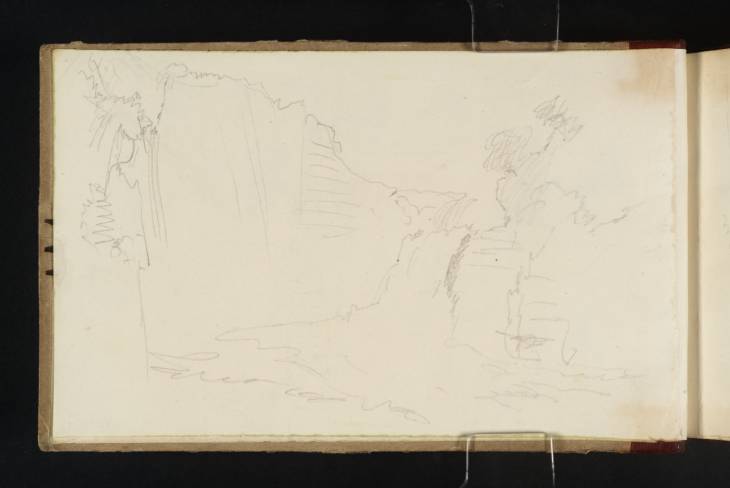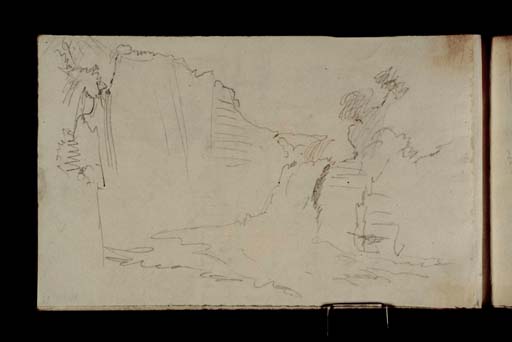Joseph Mallord William Turner Falls of Clyde: Bonnington Linn 1834
Image 1 of 2
Joseph Mallord William Turner,
Falls of Clyde: Bonnington Linn
1834
Joseph Mallord William Turner 1775–1851
Folio 1 Verso:
Falls of Clyde: Bonnington Linn 1834
D26260
Turner Bequest CCLXIX 1a
Turner Bequest CCLXIX 1a
Pencil on off-white wove paper, 113 x 190 mm
Accepted by the nation as part of the Turner Bequest 1856
References
1909
A.J. Finberg, A Complete Inventory of the Drawings of the Turner Bequest, London 1909, vol.II, p.864, CCLXIX 1a, as ‘Falls of Clyde: Bonnington Linn.’.
1990
Dr David Wallace-Hadrill and Janet Carolan, ‘Turner’s Sketches North of Stirling’, Turner Studies: His Art and Epoch 1775 – 1851, Vol.10 No.1, Summer 1990, p.12.
1974
Martin Butlin, Andrew Wilton and John Gage, Turner 1775–1851, exhibition catalogue, Royal Academy, London 1974, p.126 under no.451.
1990
Frank Milner, J.M.W. Turner: Paintings in Merseyside Collections: Walker Art Gallery; Sudley Art Gallery; Williamson Art Gallery; Lady Lever Art Gallery; Liverpool University Art Gallery, Liverpool 1990, p.68.
The ‘Falls of Clyde’ is a spectacular series of waterfalls on the River Clyde about a mile to the south of the village of New Lanark. In the late eighteenth century the falls became a popular destination for tourists of the picturesque, with one nineteenth-century guidebook claiming that ‘for majesty and grandeur [they] are not to be surpassed by any thing of the kind in the United Kingdom’.1 Turner had visited them in 1801 when he imagined them as the setting for Mark Akenside’s poem Hymn to the Naiads: The Fall of the Clyde, Lanarkshire: Noon – Vide Akensid’s Hymn to the Naiads, exhibited 1802 (Walker Art Gallery, National Museums Liverpool).2 In 1834 Turner had a different work of literature in mind: Walter Scott’s novel, Old Mortality, 1816, which is partially set in the area.3
Turner arrived in Lanark on 18 September and visited the Falls of Clyde before heading to Milton Lockhart, the home of Scott’s son-in-law and biographer, John Gibson Lockhart. Arriving in New Lanark Turner may have done as an 1838 tourist guide suggested, and proceeded to Bonnington House (no longer standing) where he may have had to seek permission to enter the grounds in order to take the path to Corra Linn and the nearby Bonnington Linn. From the path the visitor was able to ‘look down into a profound chasm, through which the troubled river pursued its furious course.’4 The guide urged the visitor to make first for the less dramatic Bonnington Linn, advising him to ‘restrain his curiosity, and advert his sight as much as possible from the intervening scenery, until he reaches Bonniton [sic] Linn.’5 Turners’ first sketches in this book are of Bonnington Linn, and are followed by Corra Linn, suggesting that he followed this established tour.
Views of Bonnington Linn on the present page and folio 2 (D26261) were made from the north-west. Turner depicts the waterfall gushing between two masses of rock and rushing through the gorge in the foreground. He added an indicator of scale on the following page by including a small figure standing on the rocks at the bottom of the gorge. From Bonnington Turner headed north up the path for a view of Corra Linn: folios 2 verso–7 (D26262–D26271). He then seems to have returned to Bonnington (7 verso–9 verso, 10 verso–12; D26272–D26276, D26278–D26281) and Corra again (folios 12 verso–13 verso; D26282–D26284). For more information on Turner’s itinerary see Tour of Scotland for Scott’s Prose Works 1834 Tour Introduction.
Thomas Ardill
February 2011
Corra Linn was chosen for the illustration to The Tale of Old Mortality, by Scott’s publisher, Robert Cadell, for his ‘Abbotsford edition’ of the Waverley Novels. Sir Walter Scott, Waverley Novels [Abbotsford edition], vol.II, Edinburgh 1843, facing title page, Edward Goodall after Clarkson Stanfield, ‘Corra-Linn, near Lanark’, engraving.
How to cite
Thomas Ardill, ‘Falls of Clyde: Bonnington Linn 1834 by Joseph Mallord William Turner’, catalogue entry, February 2011, in David Blayney Brown (ed.), J.M.W. Turner: Sketchbooks, Drawings and Watercolours, Tate Research Publication, December 2012, https://www


